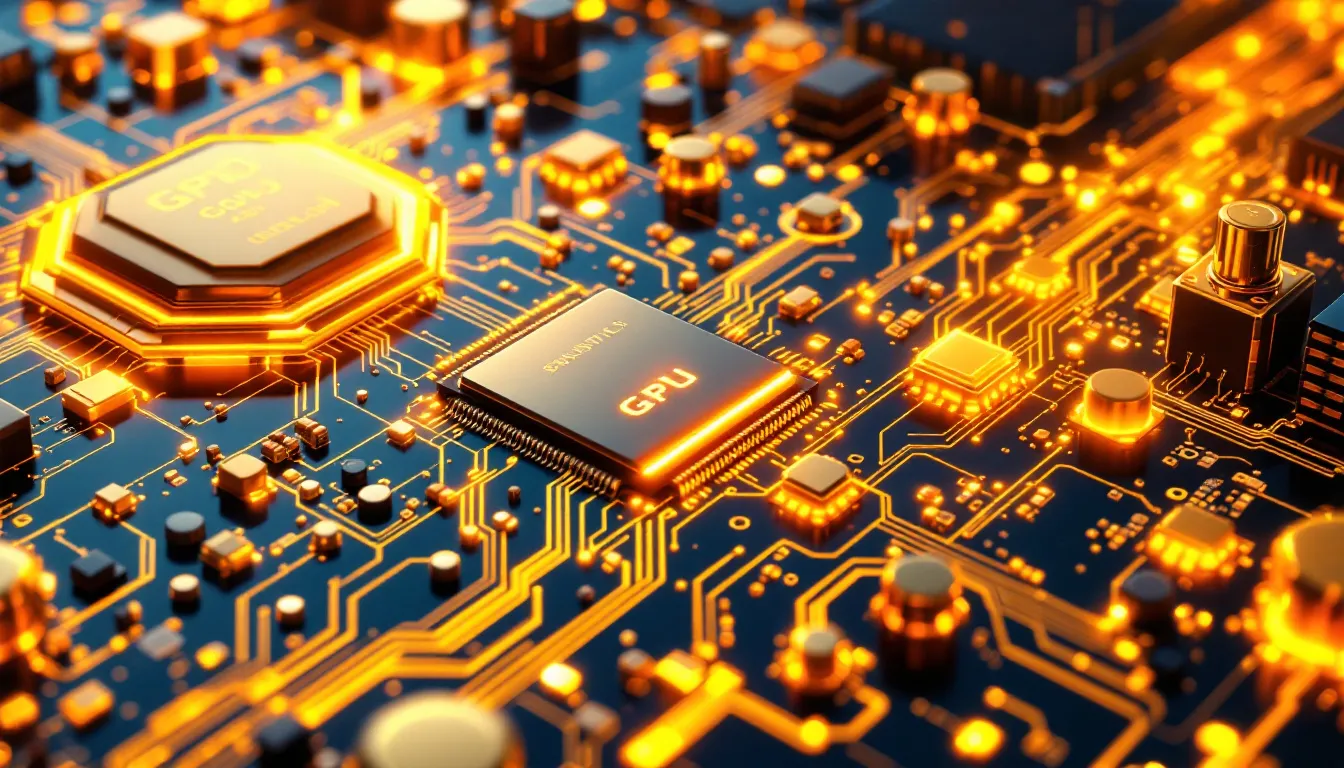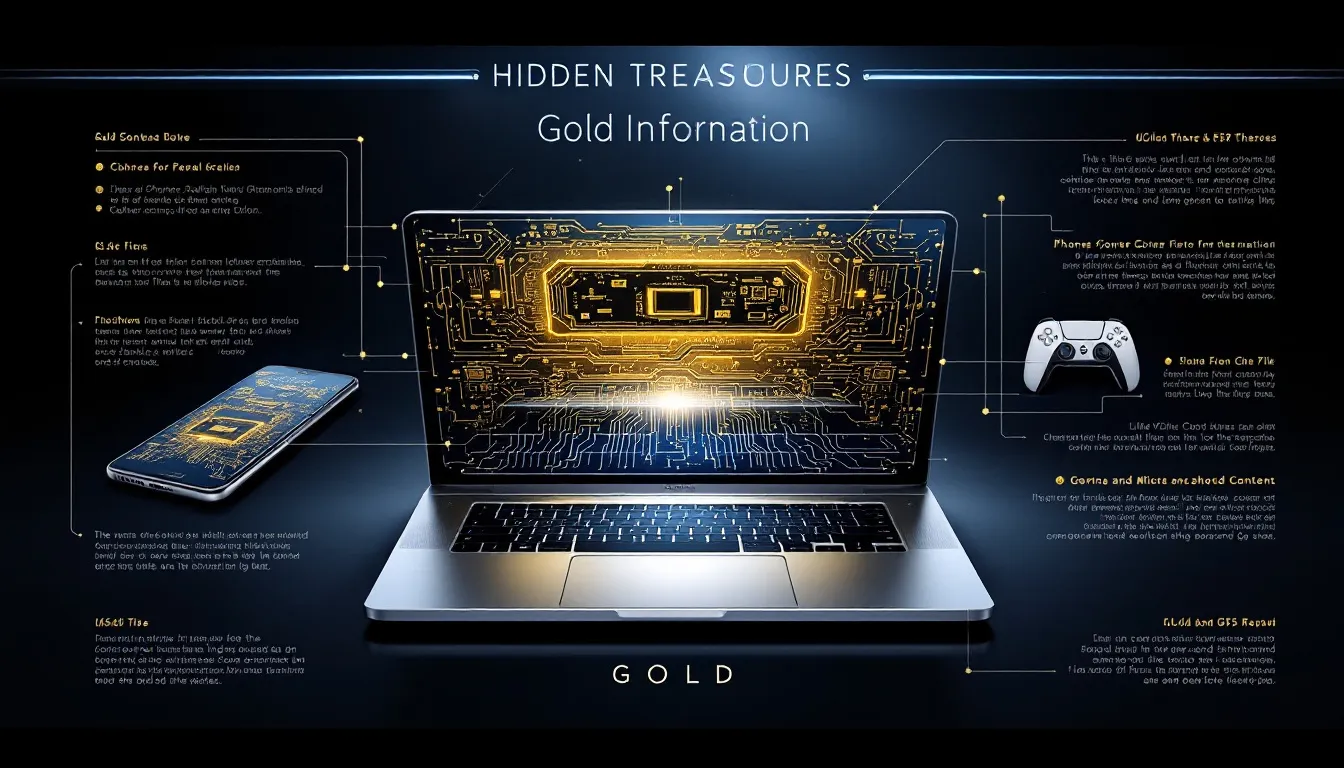A typical computer contains about 1/5th of a gram of gold, valued at around $12. You’ll find this gold in components like motherboards, processors, and circuit boards. This article explores how much gold is in a computer and how to extract it efficiently.
Key Takeaways
- A standard computer contains about 1/5th of a gram of gold, primarily found in motherboards, processors, and circuit boards, enhancing performance and reliability.
- Extracting gold from computers can be done via non-chemical methods like reverse electroplating or through chemical processes such as aqua regia, requiring proper safety precautions.
- Innovative trends in e-waste recycling, including biodegradable chemicals and biomining, aim to improve sustainability and reduce environmental impact in gold recovery.
Gold Content in a Computer

Before: Gold can be found in various parts of a computer, including motherboards, processors, and circuit boards. Computer boards, motherboards, and integrated circuits contain significant amounts of gold. Additionally, contacts, pins, and printed circuit boards also hold considerable quantities of this precious metal. Typically, a standard computer contains about 1/5th of a gram of gold, which is worth around $12.
After: Gold can be found in various parts of a computer, including:
- Motherboards
- Processors
- Circuit boards
- Integrated circuits
- Contacts
- Pins
- Printed circuit boards
Typically, a standard computer contains about 1/5th of a gram of gold, which is worth around $12.
Let’s examine where exactly this gold is located.
Amount of Gold in Processors
Processors are one of the key components in a computer that contain gold. The typical gold content from a CPU can range from 0.2 grams to 0.5 grams. Different processors may contain varying amounts of gold based on their design and function.
Gold in solid-state electronic devices prevents corrosion and tarnish on contact points, enhancing long-term reliability.
Gold in Circuit Boards
Circuit boards are another major area where gold is found. Gold is primarily located in the connectors of integrated circuits and memory chips on printed circuit boards. It plays a critical role in ensuring reliable functionality in electronic circuits within these boards.
Gold in PCBs enhances electrical conductivity, improving overall performance and durability. Recovering gold from PCBs aids recycling efforts and promotes sustainable resource use in technology manufacturing.
Other Gold-Plated Parts
Apart from processors and circuit boards, other gold-plated parts in computers include connectors, memory chips, computer chips, and circuit boards. Gold-plated connectors are vital in ensuring reliable connections in various components of a computer.
Memory chips use gold plating for efficient signal transmission and enhanced performance. Gold plating in electronic components is vital for maintaining functionality and reducing corrosion.
Why Computers Use Gold

Gold is utilized in electronics due to its superior electrical conductivity, allowing efficient electricity flow with minimal resistance. Despite being more expensive, gold’s attributes make it essential for specific components like connectors and wires in electronic devices. Gold’s excellent properties, including corrosion resistance, make it ideal for ensuring the reliability of electronic connections.
Let’s explore these properties further.
Conductivity and Performance
As an excellent conductor of electricity, gold is crucial in electronics, particularly benefiting tiny connections for effective performance.
Memory chips also feature gold plating, enhancing their connectivity and performance.
Corrosion Resistance
Gold’s non-reactive properties prevent tarnishing, making it a reliable choice for long-lasting electronic connections. Unlike other metals, gold does not corrode, ensuring extended functionality of electrical connectors.
This durability is crucial for maintaining the integrity of electronic devices.
Extracting Gold from Computers

Extracting gold from computers requires careful consideration and precision. Before attempting gold extraction from old computers, it is advisable to consider the potential precious metals recovery and to wear protective gear such as gloves and goggles while handling components.
Disassembling the computer involves removing metal elements to access gold-containing components. Non-chemical methods to extract gold from computers include using vinegar, weak acids, or reverse electroplating, while melting requires specialized equipment such as a blowtorch and clay pot.
For those who prefer not to handle the extraction process themselves, shipping the disassembled pieces to a precious metal reclamation company is a practical option.
Safety Precautions
Wearing protective gear like gloves, goggles, and aprons is essential when handling chemicals for gold extraction. Ensuring proper ventilation is also critical to avoid inhaling toxic fumes.
Safety measures are essential for protecting oneself when extracting gold from electronic waste.
Disassembling the Computer
Carefully remove components like motherboards and gold-plated connectors to access gold-containing parts. This involves dismantling the computer and separating metal elements from valuable materials.
This step is crucial for ensuring that no gold is left behind and the recovery process is efficient.
Chemical Extraction Methods
Aqua regia is used in gold extraction from computers. Recovering gold from electronic parts requires appropriate facilities and chemical expertise. A specific method is used to precipitate gold from a solution back to solid form.
Refining extracted gold from mobile phones is necessary to obtain pure gold, ensuring the removal of impurities.
Alternative Extraction Methods
Heat application and brute strength are two methods for extracting gold from electronics. Mechanical methods like heat application and physical separation can effectively recover gold. Non-chemical methods can be effective for gold recovery from electronic waste.
Non-chemical methods offer safer and more environmentally friendly options for gold extraction.
Environmental Impact of Gold Recovery

Extracting gold from e-waste prevents harmful materials from contaminating landfills and reduces the need for destructive mining. Recycling gold not only conserves the earth’s resources but also significantly reduces environmental degradation associated with mining.
Recovering gold at home poses risks like burning and poisoning from caustic acids. Chemical extraction necessitates precautions, such as working in a well-ventilated area to minimize exposure to harmful chemicals. Improper e-waste disposal can release toxic chemicals like lead and cadmium into the environment.
Innovative practices that reduce harmful chemicals and adopt circular economy principles are key to sustainable gold recovery. Biomining, which uses microorganisms to extract valuable materials from electronic waste, offers a sustainable alternative to traditional mining methods.
Reducing E-Waste
Before discarding an old phone, consider the gold hidden inside. In some regions, e-waste recycling involves harmful practices like shipping e-waste and burning it to extract materials.
By recovering gold from electronic devices, we can significantly reduce the environmental impact and promote more sustainable practices.
Minimizing Hazardous Chemicals
Innovative extraction techniques can selectively capture gold from electronics while minimizing environmental risks associated with traditional methods. Eco-friendly chemical methods, such as hydrometallurgical processes, are being developed to recover precious metals from e-waste sustainably.
Research is ongoing to develop eco-friendly solvents for reducing the environmental footprint of gold extraction from electronic waste. These chemicals aim to enhance extraction processes while minimizing environmental harm. Reducing the use of toxic chemicals is crucial for minimizing environmental impact.
Comparing Gold in Computers to Other Electronics

Computers and smartphones typically contain the most gold among electronic devices. Devices such as laptops, tablets, and desktop computers also contain significant amounts of gold. Electrical connectors and circuit boards are common components containing gold, critical for functionality.
The gold content in various devices can vary significantly based on device type and specific components used. Gold is often found in various components of old electronics, including circuit boards and connectors.
Laptops and Desktops
A typical laptop contains approximately 0.1 grams (1/10th gram) of gold, worth about $6. If you’re wondering how much gold is in a typical laptop, it’s around 0.1 grams.
Laptops and desktops contain more gold than mobile phones.
Mobile Phones and Tablets
Gold is primarily found in the circuit board of mobile phones, with a typical smartphone containing around 0.034 grams of gold. While mobile phones have relatively low amounts of gold, they still hold value. Tablets also contain gold, with amounts comparable to smartphones but varying by model.
Tablets typically contain gold amounts similar to smartphones, though this can vary by brand and model. There is no substantial difference in gold content between high-end and budget smartphones; high-end models may contain slightly more gold due to advanced components, but this is not always the case.
Gold holds both sentimental and monetary value in mobile devices, with significant gold content in iPhones contributing to their popularity and sales.
Future Trends in E-Waste Recycling
New technologies are enhancing efficiency and environmental friendliness in e-waste recycling. Research is focused on biodegradable chemicals and biomining techniques for gold recovery from e-waste. New methods for gold extraction are being developed using materials without harmful chemicals, enhancing sustainability.
The integration of a circular economy aims to extend the life cycle of materials through continuous reuse and repair.
Biodegradable Chemicals
The gold extraction process is often associated with the use of harmful chemicals, making the transition to eco-friendly alternatives essential for sustainability. Eco-friendly chemicals include substances that are less toxic than traditional reagents, helping reduce the environmental footprint of gold extraction.
Using eco-friendly chemicals minimizes toxic exposure to workers and reduces environmental contamination risk. This shift towards sustainable practices in gold extraction can improve the overall image of e-waste recycling.
Biomining Techniques
Biomining is an environmentally friendly method for extracting gold from electronic waste using biological processes. It offers a sustainable alternative to traditional mining, reducing environmental harm. Biomining typically relies on microorganisms like bacteria and archaea that metabolize minerals to release gold.
Biomining techniques often lead to lower costs and reduced waste output compared to conventional gold extraction methods. Additionally, biomining can minimize the use of hazardous chemicals, making it safer for the environment.
Summary
Throughout this exploration, we’ve uncovered the hidden gold within computers and other electronic devices. From understanding the specific components like processors and circuit boards that contain gold to the reasons why gold is used in electronics, the journey has been enlightening. Gold’s superior conductivity and resistance to corrosion make it indispensable in the tech world.
As we move towards more sustainable practices, the methods of extracting gold from electronic waste are evolving. Whether through chemical or non-chemical means, the emphasis is on minimizing environmental impact. Future trends, such as biodegradable chemicals and biomining, offer promising advancements in e-waste recycling, ensuring that we can continue to recover gold without compromising our planet.
Frequently Asked Questions
How much gold is typically found in a standard computer?
A standard computer typically contains about 1/5th of a gram of gold, valued at around $12. This small amount reflects the use of gold in electronic components for conductivity and corrosion resistance.
Why is gold used in computer components?
Gold is utilized in computer components due to its excellent electrical conductivity and corrosion resistance, which ensures reliable and efficient performance.
What are the safety precautions for extracting gold from computers?
To safely extract gold from computers, always wear protective gear such as gloves, goggles, and aprons, and work in a well-ventilated area to prevent inhalation of harmful fumes. This ensures your safety while handling potentially toxic chemicals.
How does gold recovery from e-waste benefit the environment?
Gold recovery from e-waste significantly benefits the environment by preventing harmful materials from contaminating landfills and reducing the necessity for environmentally damaging mining practices. This process promotes sustainable resource use, contributing to a healthier planet.
What are some future trends in e-waste recycling?
Future trends in e-waste recycling highlight the adoption of biodegradable chemicals and biomining techniques, offering more environmentally sustainable methods for recovering valuable materials like gold. This approach not only increases efficiency but also minimizes environmental impact.












